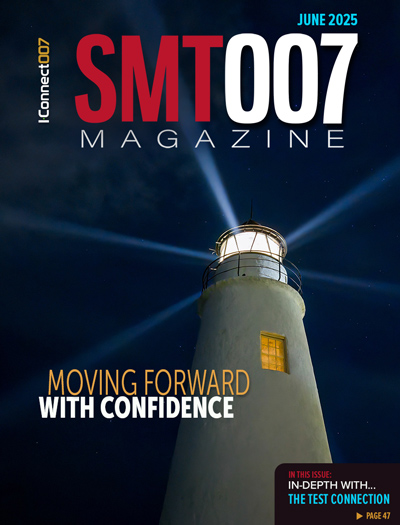-

- News
- Books
Featured Books
- smt007 Magazine
Latest Issues
Current Issue
Supply Chain Strategies
A successful brand is built on strong customer relationships—anchored by a well-orchestrated supply chain at its core. This month, we look at how managing your supply chain directly influences customer perception.

What's Your Sweet Spot?
Are you in a niche that’s growing or shrinking? Is it time to reassess and refocus? We spotlight companies thriving by redefining or reinforcing their niche. What are their insights?

Moving Forward With Confidence
In this issue, we focus on sales and quoting, workforce training, new IPC leadership in the U.S. and Canada, the effects of tariffs, CFX standards, and much more—all designed to provide perspective as you move through the cloud bank of today's shifting economic market.
- Articles
- Columns
- Links
- Media kit
||| MENU - smt007 Magazine
Vitronics Soltec Products Win Two SMT China Vision Awards in Reflow and Selective Soldering Categories
May 1, 2017 | Vitronics SoltecEstimated reading time: 2 minutes
ITW EAE’s Vitronics Soltec earned two coveted VA Excellent Awards from the SMT China Vision Awards at the recent NEPCON China exposition and conference in Shanghai. The CATHOX Catalytic Thermal Oxidizer was recognized in the Reflow Soldering category and the ZEVAm took the prize in the Selective Soldering category.
The Catalytic Thermal Oxidizer (CATHOX) is an advanced system for keeping SMT reflow ovens clean and free of contamination. A nanomaterial-based catalyst system thermo-chemically decomposes organic materials outgassed from solder paste, bare boards and components. The nanotechnology makes it possible to change the chemical composition at temperatures around 250ºC. It is very effective in removing volatile compounds from the process tunnel during reflow. In thermal oxidation, organic vapors are converted to hydrocarbons, which are captured by a filter.
“CATHOX technology significantly reduces maintenance,” said Ton Colijn, ITW EAE Soldering Solutions Business Manager. “Increased production pressure, miniaturization, and implementation of pin-in-paste increase the consumption of solder paste which typically requires more maintenance in a reflow machine. The innovative CATHOX technology is increasing uptime approximately 10one hundred percent.”
The ZEVAm Selective Soldering system features patented technology that excels at meeting the challenges of miniaturization. High-frequency drop-jet fluxing technology allows for faster robot movement and a shorter cycle time. After running through the preheater, boards are transferred into a separate conveyor unit that can be tilted in x or y direction. The board is tilted and dragged over the wave. The tilting up or down from 4 to 10 degrees parallel and/or perpendicular to the conveyor makes solder joints accessible from all directions. The solder pot can also turn 360º. This tilt and rotate ability makes it possible to solder fine pitch connectors using non-wettable as well as wettable nozzles. Together with a solder drainage conditioner bridges on fine pitch connectors will be removed.
“ZEVAm is preparing our customers for the challenges in fine pitch selective soldering” said Ton Colijn, ITW EAE Soldering Solutions Business Manager. “The ability to solder under an angle has a proven benefit for fine pitch components and provides more flexibility to program for tight ‘keep out’ areas.”
About ITW EAE
ITW Electronics Assembly Equipment (a division of Illinois Tool Works, Inc.), is the global leader in process knowledge, services and manufacture of capital equipment used in the printed circuit board assembly and semiconductor industries. The group brings together the world’s leading brands of electronics assembly equipment: MPM Printers, Camalot Dispensers, Electrovert Cleaners and Soldering Solutions, Vitronics Soltec Soldering Solutions and Despatch Thermal Processing Technology. For more information visit www.itweae.com.
Testimonial
"Our marketing partnership with I-Connect007 is already delivering. Just a day after our press release went live, we received a direct inquiry about our updated products!"
Rachael Temple - AlltematedSuggested Items
Indium Promotes Huang to Senior Manager, Marketing Communications
08/28/2025 | Indium CorporationWith its commitment to innovation and growth through employee development, Indium Corporation announces the promotion of Jingya Huang to Senior Manager, Marketing Communications, to continue to lead the company’s branding and promotional efforts.
Rehm Academy Expands Its Training Program
08/28/2025 | Rehm Thermal SystemsThe demands on modern industrial companies and employees continue to rise, and therefore, the topic of further education is becoming increasingly important today.
MacDermid Alpha Awarded for Innovation: Driving Process Optimization and Efficiency with Major Indian EMS Provider
08/28/2025 | MacDermid Alpha Electronics SolutionsMacDermid Alpha Electronics Solutions, a leading global supplier of integrated materials for the electronics industry, is recognized by one of India’s top EMS providers, Syrma SGS, with an award for innovation that advanced process optimization, enhanced operational efficiency, and yield gains.
Integrated Solutions for Board-level Reliability: A Smarter Path Forward
08/27/2025 | Alan Gardner, MacDermid Alpha Electronics SolutionsIn today’s electronics manufacturing landscape, reliability is no longer just a benchmark but a business imperative. As industries such as automotive, aerospace, and high-performance computing (HPC) push the boundaries of innovation, the demand for dependable board-level performance under extreme conditions has never been greater.
ZESTRON Expands Capabilities with Addition of the EPS by i-Tech AG 75 Pallet Cleaning System
08/26/2025 | ZESTRONZESTRON, the global leader in high-precision cleaning solutions and services, is excited to announce the addition of a new capability in its Technical Center in Manassas, VA:


